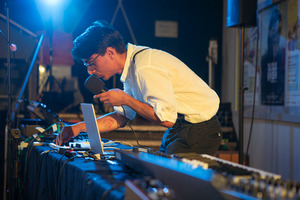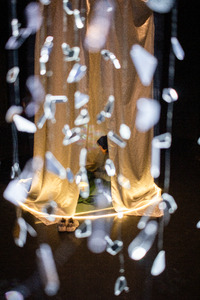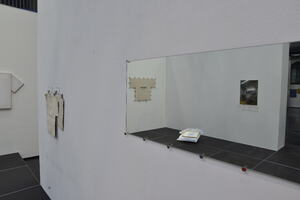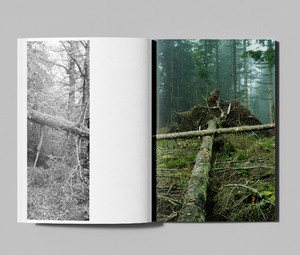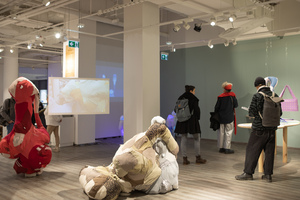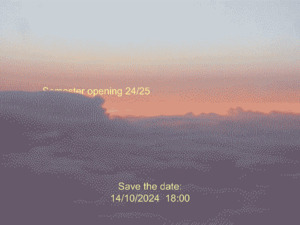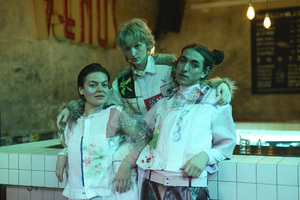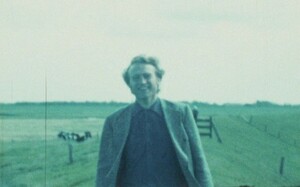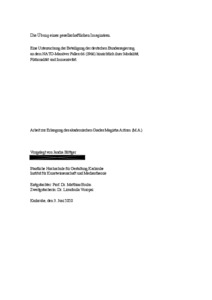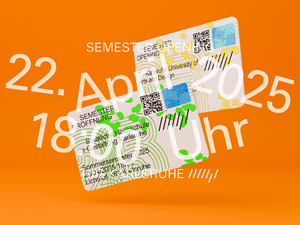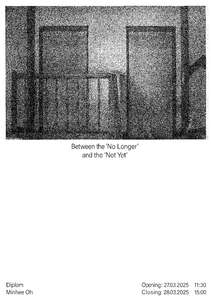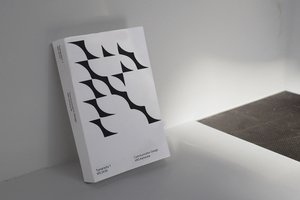existence.exe
Benachbarte Sets (116)Alle Zusammenhänge anzeigen
Diese Sets wurden den gleichen Sets hinzugefügt wie das ausgewählte Set.
116 Inhalte
- Seite 1 von 10
rOundabOut
- Titel
- rOundabOut
- Kategorie
- Titel
- rOundabOut
- Importiert am
- 15.01.2025
- Übergeordnete Sets
- 1
- Set enthält
- 1 0
RE: Home
- Titel
- RE: Home
- Titel (en)
- RE: Home
- Autor/in
- Beschreibung (de)
- Wir alle verlassen irgendwann unser erstes Zuhause (das Zuhause unserer Kindheit), entweder freiwillig oder unfreiwillig. Dieser Abschied ist mehr als nur ein physischer Umzug; er markiert den Beginn einer Reise, auf der wir uns ein neues Zuhause schaffen und gleichzeitig die Sehnsucht nach dem Zuhause der Vergangenheit zurücklassen.
Aber Zuhause ist nicht nur der Ort, an dem wir geboren und aufgewachsen sind; es ist auch der Ort (oder Zustand), an dem wir unsere Identität formen, und der psychologische Raum, in dem wir unsere Erinnerungen und Emotionen speichern. Bevor wir weggehen, erinnern wir uns an Zuhause als einen physischen Ort, der uns vertraut und beruhigend ist, aber nachdem wir weggegangen sind, wird es allmählich weniger zu einem konkreten Bild und mehr zu einem fließenden, psychologischen Konzept. Es ist nicht nur ein Verlust, sondern ein Prozess des Findens und Schaffens eines neuen Zuhauses.
In der modernen Welt, in der sich so vieles so schnell verändert, erfinden wir uns ständig neu und das Zuhause ist kein festes Konzept, sondern wird durch die Orte, Erfahrungen und Beziehungen, die wir bewohnen, neu definiert. Heimat ist unser Ausgangspunkt und bleibt nicht unbedingt an einem Ort; vielmehr bewegen und verändern wir uns und entdecken und schaffen auf diesem Weg neue Formen von Heimat.
Was bedeutet also Zuhause für uns und wie schaffen wir es?
- Wir alle verlassen irgendwann unser erstes Zuhause (das Zuhause unserer Kindheit), entweder freiwillig oder unfreiwillig. Dieser Abschied ist mehr als nur ein physischer Umzug; er markiert den Beginn einer Reise, auf der wir uns ein neues Zuhause schaffen und gleichzeitig die Sehnsucht nach dem Zuhause der Vergangenheit zurücklassen.
- Beschreibung (en)
- We all leave our first home (our childhood home) at some point, either willingly or unwillingly. This departure is more than just a physical move; it marks the beginning of a journey where we create a new home, while at the same time leaving behind a sense of nostalgia for the home of our past.
But home isn't just the place where we were born and raised; it's also the place where we form our identity, and the psychological space where we store our memories and emotions. Before we leave, home is remembered as a physical place that is familiar and comforting, but after we leave, it gradually becomes less of a concrete image and more of a fluid, psychological concept. It's not just a loss, but a process of finding and creating a new home.
In the modern world, where so much is changing so quickly, we are constantly re-creating ourselves, and home is not a fixed concept, but is redefined by the places, experiences, and relationships we inhabit. Home functions as our base point, and it doesn't necessarily stay in one place; rather, we move and change, discovering and creating new forms of home along the way.
So, what does home mean to us, and how do we create it?
- We all leave our first home (our childhood home) at some point, either willingly or unwillingly. This departure is more than just a physical move; it marks the beginning of a journey where we create a new home, while at the same time leaving behind a sense of nostalgia for the home of our past.
- Kategorie
- Typ des Projekts/Werks
- Schlagworte
- Mitwirkende
- Material
- Technik/Verfahren/Formate
- Ausstellung
- Abmessungen
- Main : 1 m x 2 m x 2 m (H x B x D), Sub ø 180 cm, H: 2.5 m
- Dauer
- The imaginative narrations take about 10 minutes. / 12.03.2025 - 14.03.2025
- Ort: Institution
- Ort
- Großes Studio
- Stadt
- Land
- Titel
- RE: Home
- Projektleiter/in
- Semester
- Studiengang
- Typ der Abschlussarbeit
- Importiert am
- 10.02.2025
- Übergeordnete Sets
- 2
- Set enthält
- 0 16
LET ME SEE (c) THE SUN
- Titel
- LET ME SEE (c) THE SUN
- Autor/in
- Beschreibung (de)
- Die Diplomarbeit „LET ME SEE (c) THE SUN“ setzt sich mit Sprache und Kommunikation auseinander, wobei das Medium Kleidung als Sprachrohr von Geschichten und als Bote von Identitäten analysiert werden soll.
Die ausgestellten Arbeiten greifen visuelle Elemente von Theaterkostümen, Bühnenrequisiten und Umkleidekabinen auf, um Besucher*innen einzuladen, sich selbst als Performer*innen von Sprache und Identität wahrzunehmen. Ein besonderer Schwerpunkt liegt dabei auf grafischen T-Shirts, da diese oft kulturelle Assoziationen oder oberflächliche Identitäten signalisieren (z. B. Bandshirts, Arbeitskleidung). Diese bekannte Struktur wird dekonstruiert und umgebaut, um Betrachter*innen die Bewohnbarkeit von Sprache zu verdeutlichen.
Die begleitende Performance beschäftigt sich mit der Mehrdeutigkeit von Sprache, die stets von persönlicher Interpretation abhängt. Wörter und Texte sind untrennbar mit ihrem Kontext sowie der Art und Weise verbunden, wie und wo sie erscheinen. In den Text-/Textil-Konstruktionen werden Wörter zu Requisiten, die Bedeutungen – sowohl offensichtlich als auch schwer fassbar – tragen und durch das Medium der Requisite von anderen „bewohnt“ werden können.
- Die Diplomarbeit „LET ME SEE (c) THE SUN“ setzt sich mit Sprache und Kommunikation auseinander, wobei das Medium Kleidung als Sprachrohr von Geschichten und als Bote von Identitäten analysiert werden soll.
- Beschreibung (en)
- The diploma project “LET ME SEE (c) THE SUN” deals with language and communication, analyzing the medium of clothing as a mouthpiece for stories and as a messenger of identities.
The exhibited works take up visual elements of theater costumes, stage props and dressing rooms to invite visitors to perceive themselves as performers of language and identity. A particular focus is placed on graphic T-shirts, as these often signal cultural associations or superficial identities (e.g. band shirts, work clothes). This familiar structure is deconstructed and rebuilt to show viewers the habitability of language.
The accompanying performance deals with the ambiguity of language, which always depends on personal interpretation. Words and texts are inextricably linked to their context and how and where they appear. In the text/textile constructions, words become props that carry meanings - both obvious and elusive - and can be “inhabited” by others through the medium of the prop.
- The diploma project “LET ME SEE (c) THE SUN” deals with language and communication, analyzing the medium of clothing as a mouthpiece for stories and as a messenger of identities.
- Kategorie
- Typ des Projekts/Werks
- Schlagworte
- Datierung
- 15.01.2025
- Mitwirkende
- Dank an
- Paul Bailey
- Jonathan Blaschke
- Céline Condorelli
- Amelie Enders
- Till Engelhardt
- Kira Fuchs
- Line-Gry Hørup
- Rafael Jörger
- Chiara Kern
- Simon Knebl
- Florian Knöbl
- Alexander Knoppik
- Barbara Kuon
- James Langdon
- Nina Overkott
- Leo Schick
- Henriette Schwabe (Jette Schwabe)
- Neele Seidel
- Isabel Seiffert
- Moritz Kamil Simon
- Charlotte Singer
- Niklas Weisenbach
- Maximilian Zschiesche
- Sprache
- Material
- Ort: Institution
- Ort
- Lichthof 3
- Stadt
- Land
- Titel
- LET ME SEE (c) THE SUN
- Projektleiter/in
- Semester
- Studiengang
- Typ der Abschlussarbeit
- Importiert am
- 11.02.2025
- Übergeordnete Sets
- 2
- Set enthält
- 0 11
In den Wald gehen
- Titel
- In den Wald gehen
- Autor/in
- Beschreibung (de)
- „In den Wald gehen“ ist eine fotografische Reise durch den Lebensraum Wald, der seine Entwicklung über die letzten Jahrzehnte sowie die Beziehung der Menschen zu diesem besonderen Ort untersucht und in einem Buch zusammenfasst. Über Interviews kommen Personen aus verschiedenen Altersgruppen zu Wort und teilen ihre Ansichten zu Themen wie Kindheit, Erinnerungen, Heimat und Veränderung in Bezug auf den Wald. Diese Interviews werden durch Bildstrecken begleitet, welche als eine Momentaufnahme den aktuellen Zustand unserer Wälder dokumentieren. Eine Broschüre fungiert als Beilage zum Buch und erarbeitet, über einen Essay, den historischen Kontext der deutschen Wälder in Bezug auf Literatur und Kunst, um kollektive Wahrnehmungsmuster aufzuzeigen und zu erläutern.
- Beschreibung (en)
- “Going into the forest” is a photographic journey through the forest, examining its development over the last few decades and people's relationship to this special place, summarizing it in a book. Through interviews, people from different age groups share their views on topics such as childhood, memories, home and change in relation to the forest. These interviews are accompanied by a series of pictures that document the current state of our forests as a snapshot. A brochure acts as a supplement to the book and uses an essay to develop the historical context of German forests in relation to literature and art in order to show and explain collective patterns of perception.
- Kategorie
- Typ des Projekts/Werks
- Schlagworte
- Datierung
- Januar 2025
- Sprache
- Abmessungen
- 180mm x 250mm
- Ort: Institution
- Ort
- Lichtbrücke
- Stadt
- Land
- Titel
- In den Wald gehen
- Projektleiter/in
- Semester
- Studiengang
- Typ der Abschlussarbeit
- Importiert am
- 11.02.2025
- Übergeordnete Sets
- 2
- Set enthält
- 0 12
25 Grad: Vernissage
- Titel
- 25 Grad: Vernissage
- Titel (en)
- 25 Grad: Opening
- Kategorie
- Datierung
- 13.02.2025
- Ort
- Postgalerie Karlsruhe / Kaiserstraße 217 / 76133 Karlsruhe
- Postgalerie Karlsruhe / Kaiserstraße 217 / 76133 Karlsruhe
- Titel
- 25 Grad: Vernissage
- Importiert am
- 24.02.2025
- Übergeordnete Sets
- 1
- Set enthält
- 0 13
Semestereröffnung Wintersemester 2024/2025
- Titel
- Semestereröffnung Wintersemester 2024/2025
- Titel (en)
- Opening Winter Semester 2024/2025
- Beschreibung (de)
- An diesem Abend lädt die HfG Karlsruhe zur feierlichen Eröffnung des Wintersemesters ein und begrüßt zu diesem Anlass nicht nur Gäste und Freunde der Hochschule, sondern vor allem neue Studierende und Mitarbeitende sowie zwei Neuberufungen:
Prof. Charlotte Eifler (Professur für Mixed Realities) und Prof. Paul Bailey (Professur für Design in den Bereichen Visuelle Kommunikation und Forschung), zwei international renommierte Künstler*innen, die nicht nur das Leben an der Hochschule, sondern auch das kulturelle Leben der Stadt Karlsruhe bereichern.
Begrüßung und Grußworte von:
Prof Constanze Fischbeck, Stellvertretende Rektorin
Dr. Albert Käuflein, Bürgermeister der Stadt Karlsruhe
Britta Wirtz, Stellvertretende Vorsitzende des Hochschulrats und Geschäftsführerin der Karlsruher Messe- und Kongress GmbH (KMK)
Wie gewohnt, wird der Eröffnungsabend auch für die Überreichung von Diplomzeugnissen an unsere Absolvent*innen genutzt. Das Bühnendesign des Abends wird von HfG-Almuni Vera Gärtner gestaltet.
Wir freuen uns außerdem auf viele spannende Projekte, Neuerungen und Termine, die an diesem Abend vorgestellt werden. Beispielsweise das in Kooperation mit dem ZKM erstmals stattfindende Forschungssymposium „Shifting Paradigms“, welches mit internationalen Gästen zur Diskussion rund um Transformationen in den Strukturen künstlerischer und wissenschaftlicher Forschung am 5. Und 6. Dezember 2024 an der Hochschule stattfinden wird.
Im Anschluss Asta After Party & Konzert mit Ildikó
- An diesem Abend lädt die HfG Karlsruhe zur feierlichen Eröffnung des Wintersemesters ein und begrüßt zu diesem Anlass nicht nur Gäste und Freunde der Hochschule, sondern vor allem neue Studierende und Mitarbeitende sowie zwei Neuberufungen:
- Beschreibung (en)
- On this evening, the HfG Karlsruhe invites you to the ceremonial opening of the winter semester and welcomes not only guests and friends of the university, but above all new students and employees as well as two new appointments:
Prof. Charlotte Eifler (Professorship for Mixed Realities) and Prof. Paul Bailey (Professorship for Design in the fields of Visual Communication and Research), two internationally renowned artists* who not only enrich life at the university, but also the cultural life of the city of Karlsruhe.
Welcome and greetings from:
Prof. Constanze Fischbeck, Deputy Rector
Dr. Albert Käuflein, Mayor of the City of Karlsruhe
Britta Wirtz, Deputy Chairwoman of the University Council and Managing Director of Karlsruher Messe- und Kongress GmbH (KMK)
As usual, the opening evening will also be used for the presentation of diplomas to our graduates. The stage design for the evening will be created by HfG alumna Vera Gärtner.
We are also looking forward to many exciting projects, innovations and dates that will be presented on this evening. For example, the research symposium “Shifting Paradigms”, which will take place for the first time in cooperation with the ZKM, which will take place at the university on December 5 and 6, 2024 with international guests to discuss transformations in the structures of artistic and scientific research.
Afterwards Asta After Party & Concert with Ildikó
- On this evening, the HfG Karlsruhe invites you to the ceremonial opening of the winter semester and welcomes not only guests and friends of the university, but above all new students and employees as well as two new appointments:
- Datierung
- 14.10.2024
- Titel
- Semestereröffnung Wintersemester 2024/2025
- Importiert am
- 24.02.2025
- Übergeordnete Sets
- 1
- Set enthält
- 0 1
Sekret
- Titel
- Sekret
- Untertitel
- Eine Tränen-Bar Performance
- Autor/in
- Beschreibung (de)
- In einer Bar, in der Innenstadt von Karlsruhe, trifft das Publikum auf ein tourendes Trio mit einer sonderbaren Geschichte: Es war einmal ein Nachtfalter, der lebte im Dschungel des brasilianischen Amazonas. Dieser Falter trug den Namen Gorgone macarea und hatte eine Angewohnheit, die für ein Lebewesen auf der Erde recht eigensinnig erschien. Gorgone macarea trank die Tränen schlafender Vögel. Für ihn: eine sichere Nahrungsquelle in unsicheren Zeiten. Da also Gorgone macareas Lebensraum sich immer mehr veränderte und auch die Vögel nach und nach wegzogen, machte der Falter sich auf, um andere Tränen zu suchen. Dabei kam ihm zu Ohren, dass der Mensch ganz besondere Tränen vergießt, wie kein anderes Lebewesen auf der Erde: Emotionale Tränen.
Und so entschloss sich der Nachtfalter, die Menschen einzuladen, um ihre Tränen mit ihm zu teilen.
Seither touren der Nachtfalter und seine zwei Kompliz*innen Sadgirl und Fluss von Bar zu Bar und lassen für einen Abend das Publikum Teil ihres Universums werden. Ein Universum – in dem Tränen die Hauptzutat des Abends sind und in jedem Cocktail serviert werden.
- In einer Bar, in der Innenstadt von Karlsruhe, trifft das Publikum auf ein tourendes Trio mit einer sonderbaren Geschichte: Es war einmal ein Nachtfalter, der lebte im Dschungel des brasilianischen Amazonas. Dieser Falter trug den Namen Gorgone macarea und hatte eine Angewohnheit, die für ein Lebewesen auf der Erde recht eigensinnig erschien. Gorgone macarea trank die Tränen schlafender Vögel. Für ihn: eine sichere Nahrungsquelle in unsicheren Zeiten. Da also Gorgone macareas Lebensraum sich immer mehr veränderte und auch die Vögel nach und nach wegzogen, machte der Falter sich auf, um andere Tränen zu suchen. Dabei kam ihm zu Ohren, dass der Mensch ganz besondere Tränen vergießt, wie kein anderes Lebewesen auf der Erde: Emotionale Tränen.
- Beschreibung (en)
- In a bar in downtown Karlsruhe, the audience encounters a touring trio with a peculiar story: Once upon a time, there was a moth living in the jungles of the Brazilian Amazon. This moth was called Gorgone macarea and had a habit that seemed rather unusual for a creature on Earth. Gorgone macarea drank the tears of sleeping birds. For the moth, it was a reliable source of nourishment in uncertain times. After all, even back then, the Amazon rainforest was considered a so-called tipping element, capable of disrupting the global climate balance. As Gorgone macarea’s habitat changed more and more, and the birds gradually disappeared, the moth set out in search of other tears. Along the way, it heard that humans shed a kind of tear unlike any other creature on Earth: emotional tears.
And so, the moth decided to invite humans to share their tears with it.
Since then, the moth and its two companions, Sadgirl and Fluss, have been touring from bar to bar, drawing the audience into their universe for one night. A universe where tears are the main ingredient of the evening—served in every cocktail.
- In a bar in downtown Karlsruhe, the audience encounters a touring trio with a peculiar story: Once upon a time, there was a moth living in the jungles of the Brazilian Amazon. This moth was called Gorgone macarea and had a habit that seemed rather unusual for a creature on Earth. Gorgone macarea drank the tears of sleeping birds. For the moth, it was a reliable source of nourishment in uncertain times. After all, even back then, the Amazon rainforest was considered a so-called tipping element, capable of disrupting the global climate balance. As Gorgone macarea’s habitat changed more and more, and the birds gradually disappeared, the moth set out in search of other tears. Along the way, it heard that humans shed a kind of tear unlike any other creature on Earth: emotional tears.
- Kategorie
- Typ des Projekts/Werks
- Schlagworte
- Datierung
- 20.12.2024
- Mitwirkende
- Dank an
- Dauer
- 40 Minuten
- Ort
- Venus Bar, Kaiserpassage
- Stadt
- Land
- Titel
- Sekret
- Projektleiter/in
- Semester
- Studiengang
- Typ der Abschlussarbeit
- Importiert am
- 26.02.2025
- Übergeordnete Sets
- 2
- Set enthält
- 0 15
Eine Neue Umwelt
- Titel
- Eine Neue Umwelt
- Titel (en)
- A New Environment
- Untertitel
- Heinrich Klotz über Architektur und Neue Medien
- Untertitel des Projekts/Werks (en)
- Heinrich Klotz on Architecture and New Media
- Autor/in
- Beschreibung (de)
- Eine filmische Montage des Archivs von Kunsthistoriker Heinrich Klotz lässt Zusammenhänge erkennen zwischen Postmoderne, digitalen Medien und der Hoffnung auf eine neue Kunst.
Die alte Umwelt ist nicht mehr vorhanden, es klaffen Lücken, ganze Städte sind dem Boden gleich gemacht worden. Kann man eine lebenswerte Stadt wiederherstellen, ohne die Aggressionen des Krieges zu verdecken? Oder sind die Ruinen eine einmalige Chance, die Innenstädte von Grund auf neu zu gestalten? Ausgehend vom Wiederaufbau der deutschen Altstädte nach dem Zweiten Weltkrieg beschäftigte den Kunsthistoriker Heinrich Klotz die Rückgewinnung eines sinnlichen Erlebens in Architektur und Kunst. So sagte er den radikalen Forderungen einer alles erneuernden funktionalen Architektur den Kampf an, da sie nur noch gesichtslose Container baute. Die postmoderne Architektur verteidigte er wiederum gegen den Vorwurf des Kitsches. Und Computerspiele und virtuelle Realitäten erhob er zu Kunstwerken. 1984 gründete er das Deutsche Architekturmuseum in Frankfurt und 1989 das Zentrum für Kunst und Medien in Karlsruhe.
- Eine filmische Montage des Archivs von Kunsthistoriker Heinrich Klotz lässt Zusammenhänge erkennen zwischen Postmoderne, digitalen Medien und der Hoffnung auf eine neue Kunst.
- Beschreibung (en)
- A cinematic montage of the archive of art historian Heinrich Klotz reveals connections between postmodernism, digital media, and the hope for a new art.
The old environment is no longer there—gaps remain, entire cities have been leveled. Can a livable city be restored without covering up the aggressions of war? Or are the ruins a unique opportunity to redesign city centers from the ground up? Beginning with the post-World War II reconstruction of German historic towns, art historian Heinrich Klotz focused on reclaiming a sensual experience in architecture and art. He opposed the radical demands of an all-renewing functionalist architecture, which, in his view, only produced faceless containers. At the same time, he defended postmodern architecture against accusations of kitsch. He even elevated video games and virtual realities to the status of artworks. In 1984, he founded the German Architecture Museum in Frankfurt, followed by the Center for Art and Media in Karlsruhe in 1989.
- A cinematic montage of the archive of art historian Heinrich Klotz reveals connections between postmodernism, digital media, and the hope for a new art.
- Kategorie
- Typ des Projekts/Werks
- Schlagworte
- Datierung
- 2019
- Mitwirkende
- Sprache
- Untertitel (Film)
- Material
- Technik/Verfahren/Formate
- DCP, 2K, 3.0 in 5.1
- Abmessungen
- 4:3
- Dauer
- 01:19:05
- Land
- Beteiligte Institution(en)
- Bemerkungen
- Gefördert durch die Riemschneider Stiftung, die Gesellschaft zur Förderung der Kunst und Medientechnologie e.V. und das Zeitbild-Lab der HfG Karlsruhe.
Unterstützt durch den Südwestrundfunk, den Hessischen Rundfunk, dem Zentrum für Kunst und Medien Karlsruhe, Andec Filmtechnik und DCM - Digital Cinema Mastering.
Eine Studiolo Film Produktion
- Gefördert durch die Riemschneider Stiftung, die Gesellschaft zur Förderung der Kunst und Medientechnologie e.V. und das Zeitbild-Lab der HfG Karlsruhe.
- Titel
- Eine Neue Umwelt
- Projektleiter/in
- Semester
- Studiengang
- Typ der Abschlussarbeit
- Importiert am
- 03.03.2025
- Übergeordnete Sets
- 2
- Set enthält
- 0 7
Die Übung eines gesellschaftlichen Imaginären
- Titel
- Die Übung eines gesellschaftlichen Imaginären
- Untertitel
- Eine Untersuchung der Beteiligung der deutschen Bundesregierung an dem NATO-Manöver Fallex 66 (1966) hinsichtlich ihrer Modalität, Fiktionalität und Immersivität.
- Autor/in
- Beschreibung (de)
- „How do imaginaries claim normativity? A society can only function if enough people envision the same imaginary, says Castoriadis. I claim, that new imaginaries need to be exercised, if they are to claim normative power. This paper investigates a homogenization process of a social imaginary: In the 1966 German civil defense exercise Fallex 66, 33 members of the West German parliament simulated the at this point intensely disputed Emergency Laws. This paper argues that the fusion of fictional and real elements in the exercised scenario, combined with a bodily and affective immersion in a bunker setting had the power to shift a social imaginary. By presenting the Emergency Laws in a conservative patriarchal imaginary landscape, the exercise induces a normative shift in the social perception of the Laws. This paper sheds a leftist light on the struggle, highlighting the political bias of the exercise, as well as giving a new vocabulary to the left critique of that time. With a unique conceptual set-up, this paper investigates the imaginaries transported by and the means of their production in the civil defense exercise. Hereby, I suggest a methodical set for the analysis of social imaginaries at the cutting surface of aesthetics, affect theory, contemporary history, and social philosophy.”
- Beschreibung (en)
- „How do imaginaries claim normativity? A society can only function if enough people envision the same imaginary, says Castoriadis. I claim, that new imaginaries need to be exercised, if they are to claim normative power. This paper investigates a homogenization process of a social imaginary: In the 1966 German civil defense exercise Fallex 66, 33 members of the West German parliament simulated the at this point intensely disputed Emergency Laws. This paper argues that the fusion of fictional and real elements in the exercised scenario, combined with a bodily and affective immersion in a bunker setting had the power to shift a social imaginary. By presenting the Emergency Laws in a conservative patriarchal imaginary landscape, the exercise induces a normative shift in the social perception of the Laws. This paper sheds a leftist light on the struggle, highlighting the political bias of the exercise, as well as giving a new vocabulary to the left critique of that time. With a unique conceptual set-up, this paper investigates the imaginaries transported by and the means of their production in the civil defense exercise. Hereby, I suggest a methodical set for the analysis of social imaginaries at the cutting surface of aesthetics, affect theory, contemporary history, and social philosophy.”
- Kategorie
- Schlagworte
- Datierung
- 3. Juni 2020
- Sprache
- Ort: Institution
- Titel
- Die Übung eines gesellschaftlichen Imaginären
- Projektleiter/in
- Semester
- Studiengang
- Typ der Abschlussarbeit
- Archiv-Signatur
- HfG HS 2020 03
- Externes Archiv
- Importiert am
- 30.03.2025
- Übergeordnete Sets
- 2
- Set enthält
- 0 4
Semestereröffnung Sommer 2025
- Titel
- Semestereröffnung Sommer 2025
- Titel (en)
- Semester Opening Summer 2025
- Autor/in
- Beschreibung (de)
- Eröffnung des Sommersemesters am Dienstag, 22. April 2025 um 18.00 Uhr an der HfG Karlsruhe. Eintritt frei.
Die Staatliche Hochschule für Gestaltung (HfG) Karlsruhe kann das Sommersemester 2025 mit einer guten Nachricht eröffnen: Neben einer Reihe neuer Mitarbeiterinnen und Mitarbeiter sind wieder neue Berufungen zu feiern.
Wie gewohnt, wird der Eröffnungsabend auch für die Überreichung von Diplomzeugnissen genutzt. Neben einigen Grußworten sind außerdem performative Beiträge zu erleben. Im Anschluss an den offiziellen Teil des Abends dürfen sich Studierende und Gäste auf einen gemeinsamen musikalischen Ausklang im Lichthof freuen.
Weitere Details folgen.
- Eröffnung des Sommersemesters am Dienstag, 22. April 2025 um 18.00 Uhr an der HfG Karlsruhe. Eintritt frei.
- Beschreibung (en)
- Opening of the summer semester on Tuesday, April 22, 2025 at 6pm at HfG Karlsruhe. Free Entry
The Karlsruhe University of Arts and Design (HfG) can open the 2025 summer semester with good news: In addition to a number of new employees, there are once again new appointments to celebrate.
As usual, the opening evening will also be used for the presentation of diploma certificates. In addition to a few welcoming speeches, there will also be performative contributions. Following the official part of the evening, students and guests can look forward to a musical finale together in the atrium.
Further details will follow.
- Opening of the summer semester on Tuesday, April 22, 2025 at 6pm at HfG Karlsruhe. Free Entry
- Datierung
- 22.04.2025
- Ort: Institution
- Titel
- Semestereröffnung Sommer 2025
- Importiert am
- 15.04.2025
- Übergeordnete Sets
- 1
- Set enthält
- 0 1
Between the 'No Longer' and the 'Not Yet'
- Titel
- Between the 'No Longer' and the 'Not Yet'
- Autor/in
- Beschreibung (de)
- Der Titel dieser Ausstellung, "Between the 'No Longer' and the 'Not Yet'", stammt aus den Schriften von Victor Turner über Liminalität. Turner beschreibt Liminalität als einen Übergangszustand – einen Moment, in dem man eine frühere Rolle oder einen früheren Status verlassen hat aber noch nicht vollständig in eine neue Position eingetreten ist. Es ist ein Zustand der Ungewissheit und Transformation. Vertraute Strukturen lösen sich auf und lassen einen in einer undefinierten und instabilen Lage zurück.
Dieses Konzept spiegelt meine Erfahrung als Ausländerin in Deutschland wider. Ich habe Korea verlassen, befinde mich aber noch immer in einem Schwebezustand, ohne mich vollständig angekommen zu fühlen. Um diesen Zustand des Dazwischen auszudrücken, habe ich Flure als visuelle Metapher verwendet. Beim leisen Umherwandern durch diese Flure, beim Fotografieren aus der Distanz, bin ich mir selbst begegnet.
Aus dem fotografischen Projekt entwickelte sich die Videoarbeit "The Act of Cleaning" (2025), die gemeinsam mit den Fotografien gezeigt wird. Inspiriert von Mary Douglas' Ideen zu Reinigungsritualen – bei denen das Säubern Ordnung in das Chaos bringt –, habe ich das Putzen zu meinem eigenen Ritual gemacht. Douglas argumentiert, dass Gesellschaften Ordnung schaffen, indem sie Dinge in klare Kategorien einteilen. Doch Wesen oder Konzepte, die sich diesen Kategorien entziehen – wie Migrant*innen, Hybride oder diejenigen in Übergangszuständen –, werden oft als störend empfunden. In diesem Kontext wurde das Reinigen zu einem Weg, mit der Spannung des Dazwischenseins umzugehen.
Mit bloßen Händen wischte ich jede Stufe der Treppen ab, durch die ich mich bewegte. Die Reibung zwischen Lappen und Boden, das Geräusch des ausgewrungenen Wassers und das Echo meiner Schritte füllten den Flur. Der Boden wurde vollkommen durchnässt – die Grenze zwischen Reinigen und Verschmutzen verschwamm. Diese repetitive, beinahe meditative Handlung veränderte meine Beziehung zu diesen Räumen. Das Putzen wurde mehr als eine praktische Geste – es wurde zu einem Akt, meine Präsenz zu behaupten und sie zugleich zu hinterfragen.
Wie kann ich hier existieren?
- Der Titel dieser Ausstellung, "Between the 'No Longer' and the 'Not Yet'", stammt aus den Schriften von Victor Turner über Liminalität. Turner beschreibt Liminalität als einen Übergangszustand – einen Moment, in dem man eine frühere Rolle oder einen früheren Status verlassen hat aber noch nicht vollständig in eine neue Position eingetreten ist. Es ist ein Zustand der Ungewissheit und Transformation. Vertraute Strukturen lösen sich auf und lassen einen in einer undefinierten und instabilen Lage zurück.
- Beschreibung (en)
- The title of this exhibition, "Between the 'No Longer' and the 'Not Yet'", comes from Victor Turner's writings on liminality. Turner describes liminality as a transitional state—when one has left behind a previous role or status but has not yet fully entered a new one. It is a state of ambiguity and transformation. Familiar structures dissolve, leaving one in an undefined and unstable position.
This concept reflects my experience as a foreigner in Germany. I left Korea, yet I find myself lingering in a liminal state, not fully settled. To convey this in-between state, I used hallways as a visual metaphor. Wandering through hallways quietly, photographing them from a distance, I came face to face with myself.
This photographic project developed into the video work, "The Act of Cleaning" (2025), which is presented alongside the photographs. Inspired by Mary Douglas's ideas on purification rituals—where cleaning imposes order on chaos—I chose cleaning as my own ritual. Douglas argues that societies create order by classifying things into clear categories. Yet, beings or concepts that defy these categories—such as migrants, hybrids, or those in transitional states—are often seen as unsettling. In this context, cleaning became a way to navigate the tension of existing in ambiguity.
Using my bare hands, I wiped down each step of the staircases I walked through. The friction between the rag and the floor, the sound of squeezing water, and the echo of my footsteps filled the hallway. The floor became completely soaked, blurring the boundary between cleaning and staining. This repetitive, almost meditative act transformed my relationship with these spaces. Cleaning became more than a practical gesture—it was a way to assert my presence while simultaneously questioning it.
In what ways can I exist here?
- The title of this exhibition, "Between the 'No Longer' and the 'Not Yet'", comes from Victor Turner's writings on liminality. Turner describes liminality as a transitional state—when one has left behind a previous role or status but has not yet fully entered a new one. It is a state of ambiguity and transformation. Familiar structures dissolve, leaving one in an undefined and unstable position.
- Kategorie
- Typ des Projekts/Werks
- Schlagworte
- Datierung
- 29.05.2025
- Mitwirkende
- Dank an
- Ort: Institution
- Ort
- Lichthof
- Stadt
- Land
- Titel
- Between the 'No Longer' and the 'Not Yet'
- Projektleiter/in
- Semester
- Studiengang
- Typ der Abschlussarbeit
- Importiert am
- 29.05.2025
- Übergeordnete Sets
- 2
- Set enthält
- 0 9
Typography 1
- Titel
- Typography 1
- Titel (en)
- Typography 1
- Untertitel
- Characteristic Characters
- Untertitel des Projekts/Werks (en)
- Characteristic Characters
- Beschreibung (de)
- You’re the main characters! You’re such NPCs! Your character development was so good! Your character design is still a bit wonky! Sometimes you act out of character but you’re my favorite Characters! <3
Dieses Seminar ist eine praktische Einführung in die Typografie. Wir werden Buchstaben zeichnen und etwas über Schriftsysteme und das Alphabet lernen, Buchstaben zeichnen und ein Vokabular aufbauen, um über Buchstabenformen, die Unterschiede und Klassifizierungen von Schriften zu sprechen, Buchstaben zeichnen und die Lesbarkeit und den Charakter bewerten, Buchstaben zeichnen und einen Blick auf historische und zeitgenössische Kontexte wie Volkstypografie, Branding und Popkultur werfen.
- You’re the main characters! You’re such NPCs! Your character development was so good! Your character design is still a bit wonky! Sometimes you act out of character but you’re my favorite Characters! <3
- Beschreibung (en)
- You’re the main characters! You’re such NPCs! Your character development was so good! Your character design is still a bit wonky! Sometimes you act out of character but you’re my favorite Characters! <3
This seminar is a practical introduction to typography. We will draw letters and learn about writing systems and the alphabet, draw letters and build a vocabulary to speak about letterforms, the differences and classifications of typefaces, draw letters and evaluate readability and character, draw letters and look at historical and contemporary contexts such as vernacular typography, branding and pop culture.
- You’re the main characters! You’re such NPCs! Your character development was so good! Your character design is still a bit wonky! Sometimes you act out of character but you’re my favorite Characters! <3
- Typ des Projekts/Werks
- Schlagworte
- Datierung
- 23.10.2024 - 12.02.2025
- Mitwirkende
- Ort: Institution
- Ort
- 202
- Titel
- Typography 1
- Projektleiter/in
- Semester
- Studiengang
- Importiert am
- 12.06.2025
- Übergeordnete Sets
- 1
- Set enthält
- 0 30
